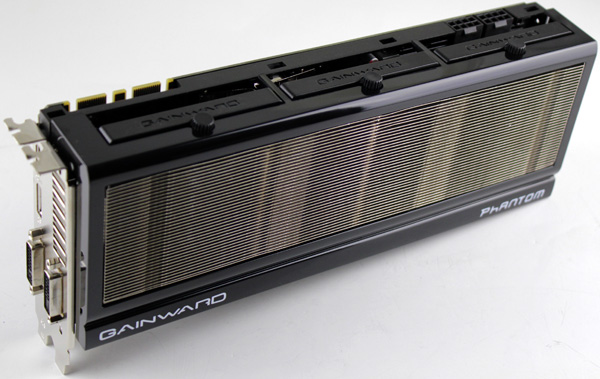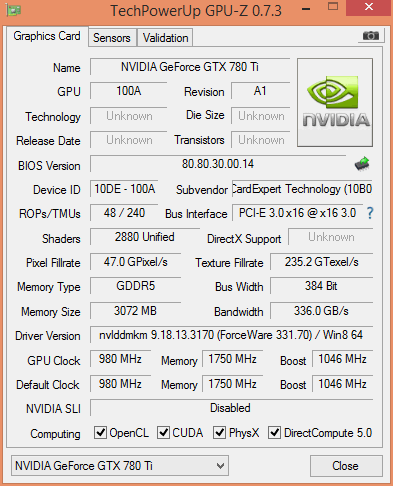Index


Review: Cooler and faster
The GTX 780 Ti is Nvidia’s new flagship graphics card and we all know AIBs like to show off when it comes to flagship products. Gainward is no exception and its GTX 780 Ti Phantom card which comes with a factory overclock and custom Phantom cooler. Last week we shared our first thoughts with our readers and at that time we could not find the Phantom card listed in online shops. In the meantime Gainward’s marketing team went into action and now we can find the card listed in at least 50 shops. Gainward’s plain GTX 780 Ti, based on the reference design, is widely available for 585 euro, while the Phantom card usually costs 40 to 50 euro more.
Gainward decided to use the 980MHz for the base GPU clock, which is significantly higher than 875MHz reference clock. According to Gainward, this was enough to make the GTX 780 Ti Phantom one of the fastest single-GPU graphics card on the market as it ends up to 10% faster than the reference GTX 780 Ti. Off course we will take a closer look at this claim.

Before we move to test results let’s refresh our memory. Nvidia launched the GK110 in May as the Geforce GTX 780 that came with 2304 CUDA cores, 192 texture mapping units (TMUs), 48 render output units (ROPs) and 3GB of GDDR5 memory running on a 384-bit memory bus.
Specification wise the GTX 780 ended up with 50% more CUDA cores than its predecessor, the GTX 680, and this among some other things gives the GTX 780 card a significant performance boost, although the GK110 is based on the Kepler architecture of GTX 680 fame. The GK104 chip used in the GTX 680 has 1536 CUDA cores. The memory bandwidth got increased, too, thanks to the wider 384-bit bus. The GTX 780 has a 384-bit bus while the GTX 680 is limited to a 256-bit interface, but the memory speed on both cards is 6008MHz.The frame buffer was increased from 2048MB to 3072MB of GDDR5 memory.
Compared to GTX Titan ($999), the GTX 780 debuted at a more attractive price of $649. Nvidia’s response to AMD’s Hawaii was to slash the GTX 780 price by $150 and launch the Geforce GTX 780 Ti.
The GTX 780 Ti has 25 percent more cores than the original GTX 780 and it has the same size as any GK110 chip, 533 mm2. The suggested retail price for the Geforce GTX 780 Ti was set at $699. The GK110-425-B1 that powers the GTX 780 TI has 5 graphics processing clusters, 15 streaming multiprocessors, 2880 CUDA cores, 240 TMUs, 48 ROP units, and 3GB of GDDR5 memory running on a 384 memory bus. GTX 780 Ti card comes with faster memory 7000MHz effective, compared to the 6008MHz on the GTX 780.
Note that the Gainward GTX 780 Ti Phantom comes with a hefty factory overclock which raises the GPU clock by 104MHz, but the memory is still running on reference clocks, i.e. 7000MHz (effective GDDR5).

Important new features announced alongside the GTX 780 Ti are ShadowPlay, an automatic game recorder that uses GPU for this purpose and it comes with Geforce Experience 1.7 and higher, and Shield PC streaming as well as G-Sync readiness. These new features should help add a bit more appeal to the GK110. G-Sync can synchronize Geforce Kepler cards and your G-Sync capable monitors and will come later this year, with real availability in early 2014. This technology will eliminate frame stuttering and tearing due to a lack of synchronization between your graphics card and monitor, but it requires a new G-Sync enabled monitor and works only on Kepler cards, GTX 780 Ti included. The Geforce GTX 780 Ti also features the same GPU Boost 2.0 technology used in the Geforce GTX Titan, with more advanced controls for auto-overclocking, fan control, and hardware monitoring.
Note that the Geforce GTX 780 Ti and GTX 780 Ti Phantom cards come with Assassin's Creed IV: Black Flag, Batman: Arkham Origins, and Splinter Cell Blacklist.

